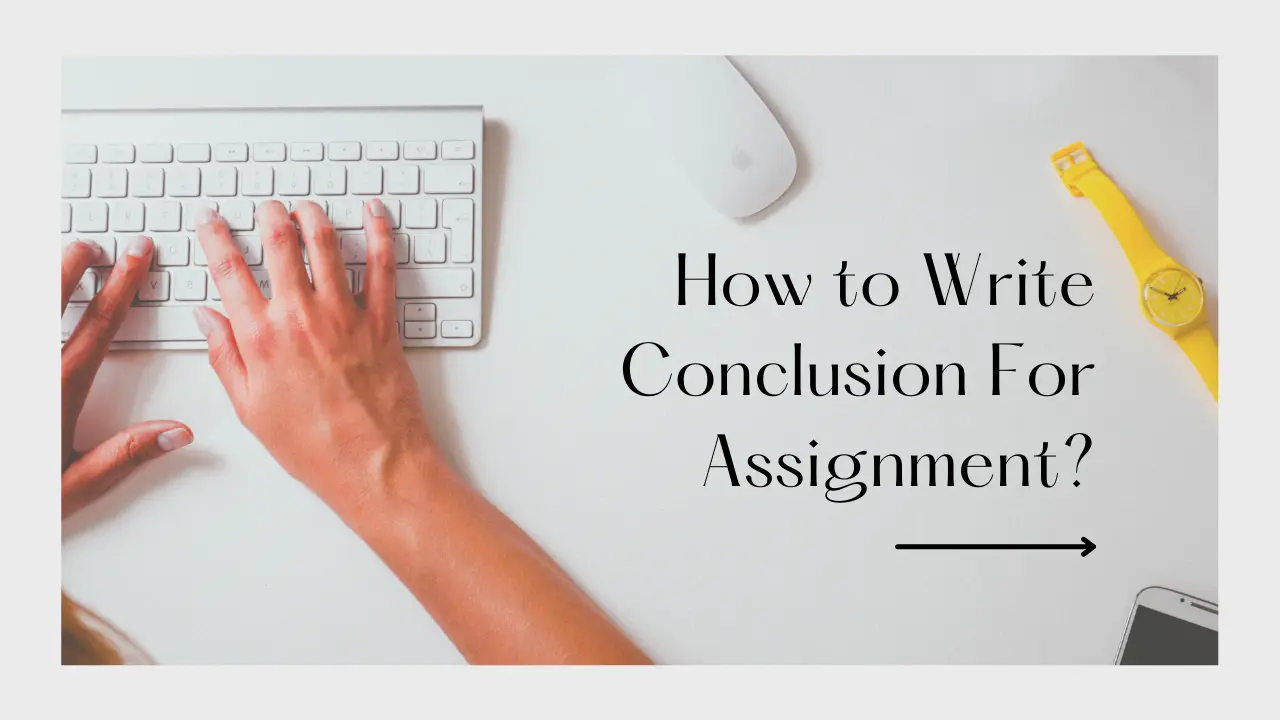Have you ever seriously thought about how to write conclusion for assignment and give an extra bonus factor to your paper? You can end your doubts through this write-up that covers the top-to-bottom aspects of writing the conclusion part for your assignment. By the end of this blog, you will be an expert in writing engaging conclusions!
What is Known as a Conclusion in an Assignment?
The conclusion part covers the outcomes you reach while analyzing and solving your assignment query. Or, you can say that this section briefly summarizes the topic with an interesting hook for the reader to reflect on in future.
When and Why Conclusion is Used in Assignment Papers?
Writing a conclusion for assignment introduction comes at the ending part of the paper. The whole point of writing a particular paper is summarized in an interesting way for the reader to eliminate any further doubts remaining in their minds. A well-written conclusion acts as a fitting closure wherein you must establish whether you have gained the purpose of addressing the particular topic in your paper.
Learn About the Different Types of Conclusion
Based on the type of impact you intend to create within your reader, conclusions are classified into three types:
Editorialization
This type is primarily used while addressing a controversial topic or if you try to build a personal connection with the reader. Therefore, the writing is done in a conversational with assignment help services tone, together with anecdotes, to convey your personal opinion about the topic.
Externalization
This form is commonly used to write topics that come under the umbrella of a complex subject. As the name suggests, externalization coursework writing service pushes the reader towards an external matter related to the main topic and persuades them to further think about it in future.
Summarization
Summarization deals with the summary of main points written in a clinical tone. Here, you must not portray your personal opinions or an individual perspective. Summarization is often written in long pieces.
What is the Role Played by Conclusion in an Assignment Paper?
Concluding an assignment is a huge responsibility. Bringing a connection between the points discussed in the main body and introduction and conveying the overall purpose of the paper seems easier from the outside. However, as a writer, you must put on your thinking caps to reflect the same on your paper without distracting the reader. An awesome conclusion can:
Stir the Reader
Your conclusion must move the reader to the core. This will create a positive impression about you as a student and a human being.
Collect the Thoughts
A striking conclusion will support the reader in gathering the perspectives they gained from the other sections towards their final thoughts about the topic.
Create a Longer Impression
Your conclusion must push your reader further into a loop wherein they constantly think about the topic and other related elements for a longer period.
Inspire the Audience
A well-written conclusion part can demonstrate the importance of the topic and motivate the reader to contribute from their side in terms of the issue discussed in the paper.
What Must be Included in the Conclusion Part?
The vital aspect you must learn while understanding how to write conclusion for assignment is the fact that the reader must be able to arrive at a final thought. Your conclusion must be strong and attractive enough to maintain the attention of the reader and parallelly draw them from the intro and main headings to the concluding part. Try to make your readers feel that they have finally arrived at the conclusion of the topic!
Things to Remember While Concluding an Assignment!
- Include strong and optimistic points
- Make the readers immersed in a tone that reflects closure or ending
- Brief the importance of the topic and don’t write about any new arguments
- Talk about the objectives you have gained through the paper
Take a Note of These Effective Strategies to Write a Conclusion for Assignment!
Before writing your conclusion sentences, memorize these points and apply them to get stunning results!
Reiterate the main points discussed
Summarize the points discussed in the earlier sections of the paper in a way that reminds the audience about the purpose of addressing the topic.
Try to give a hook statement
Think about a quote or any catchy statement that can convey the essence of the whole topic. A simple yet thought-provoking statement can give a 360-degree boost to the paper, increasing its creativity and impact.
Avoid introducing anything fresh
Always stop yourselves from starting a new argument. Introducing a new segment will completely contradict the purpose of a conclusion statement. Remember that you are concluding an assignment, so, treat the content accordingly.
Make your content brief
Always remember that your conclusion must contain only a short content. Compared to other sections, conclusions must not be explanatory. However, it must be eye-catching and on-point.
Connect your points
Rather than writing a general piece of content, connect the opinions discussed and give a broad picture for your readers to brainstorm. In other words, give an open ending that can etch the topic in their minds for a long time.
How to Write a Perfect Conclusion?
Following these points will help you draft a conclusion that can steal hearts!
Separate the conclusion paragraph
By giving a blank line or space, offer a separation between the previous section and the conclusion part.
Use apt words
Do you know that there are suitable words and phrases to indicate that you are concluding something? Use them in your paper and prevent confusion amongst the readers.
Revisit the intro
Read the introduction part carefully and rephrase the intro statement to convey that you have finally arrived at the solution.
Brief the points in the main body
Summarize the information written in the main body paragraphs in short points or sentences. At the same time, don’t go for an explanation. Try to bring the substance of other sections in the form of major points.
Write a sentence that lasts
Proofread the content
If possible, depend on an expert for their perspective. This will ensure that your content is highly readable and free from errors in terms of vocabulary or logical flow.
Check Out These Assignment Conclusion Example!
In short, artificial technology is slowly strengthening its claws around our world. Its eventual progress towards reigning multiple sectors is equally advantageous and threatening. While one section may strongly argue that this contribution of modern-age technology must continue its territory expansion, I believe one must have strong control over it to prevent greater damage to society and lives. Though everyone enjoys watching movies like Terminator, not a single individual in the human race will enjoy living through such a horrific situation! Deciding the threshold point in terms of utilizing the technology is still a widely discussed matter, however, it is high time to notice that with every passing second, we are gradually becoming mere puppets of automation and future technologies.
On close analysis of the global crime rates and their contributing parameters, including the childhood trauma and other psychological factors of those who indulge in brutal crimes, it seems that the word ‘peace’ has lost all its essence. Nevertheless, there is a ray of hope in the form of modernistic counselling techniques and behavioural therapies that can weed out the root cause of such criminal instincts. Such a strategic approach and application of psychological methods can erase the traits or possibilities of criminal behaviour at the preliminary stage. But to make this possible, it is significant to make the public aware of mental health and the dire need to rely on expert psychologists or psychiatrists. Additionally, it is important to give extra attention to the young children and their upbringing. The quote by Dr. Gabor Mate, ‘Children don’t get traumatized because they are hurt. They get traumatized because they’re alone with the hurt’, should be comprehended on a deeper level to devise a countermeasure for this phenomenon.
Use These Phrases While Writing a Conclusion for Assignment!
As mentioned earlier, there are some specific terms in English that directly indicate that your assignment has reached its final part. We have listed some useful words from professional assignment writing service and phrases that you can use in your concluding content:
- In conclusion
- To summarize
- In general
- In short
- Altogether
- Ultimately
- Bearing all this in mind
- In view of this information
- On close analysis
- Upon consideration of the facts discussed
- At this point, it seems clear that
- Before concluding
- and so on….
Always Remember This Basic Structure For Writing the Conclusion!
- The conclusion is exactly opposite to that of an introduction. That is, begin with a specific point and end with a general one.
- Try to make the reader remember the intro part and other sections.
- Don’t let the reader forget about the paper, once they have finished reading dissertation writer it. Immerse them in the hangover of the information they have received and push them towards contemplating the same for a while.
Conclusion
Dissecting and learning closely about each and every aspect of how to write a conclusion for assignment has finally reached a conclusion! Writing an ending statement for your paper is actually a simple technique if you are thorough with the topic research paper helper and have sufficient knowledge about the main points. You don’t have to write about anything new except rework whatever statements you have made while writing the introduction paragraph.
We hope this blog helped you receive a clear picture of what you didn’t know about how to write a conclusion. Your conclusion must be written with the same level of dedication and creativity as that of your introduction. Our team has exclusively prepared assignment conclusion example to help you understand the same. If your doubts still prevail, you can ask our experts in the comment section or directly contact our team. Also, share your opinions about this blog in the comments below!
FAQ
How do you start a conclusion for an assignment?
You can start your conclusion using certain words or phrases that convey to the reader that they have landed the conclusion page. It is also advisable to repeat the intro argument and write whether you have reached a fitting solution.
Can I write a conclusion in just 7 lines?
Aiming for a particular count of sentences can eliminate the soul of your concluding content. Despite bothering about the count, focus on the material and how to make it worth seeking attention.
How long should a conclusion be?
There is no ideal number of words or sentences in terms of writing a conclusion for assignment. The aim should be to write a small description of what the audience has read till now without going for an explanation style.
Is it fine to include quotes while concluding an assignment?
Yes. You can include quotes that complement the meaning of the write-up. A quote can sometimes be the pivotal point that can provide a reader utmost satisfaction and everlasting impact.









